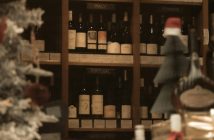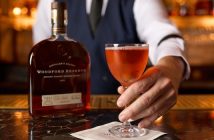In business premier we watch the bubbles rise out of our glasses as the grey, angry traffic and drizzly landscape of the UK speeds past our reflections. We are abord l’Eurostar, en-route to Reims and ready for a golden 48hrs under skies infinitely more sparkling than the ones we leave behind. In Paris, a darkened-chauffeured vehicle meets us at the station for swift onwards travel to the home of original glamazon of Champagne: Armand de Brignac. Charged with luxury lunchboxes from chic Parisien grocer ‘Le Nôtre’, our sights are set on a horizon brim-full of shiny Champagne bottles and a journey into the craftsmanship of this similarly high-end global brand.
“I am under no pressure to make wine for wine’s sake,” says Alexandre Cattier a little later on as we stand in his Clos de Moulin vineyard, deep in the heart of Chigny-Les-Roses. From our hilltop position we can see for miles over the green and verdant, well-maintained vines, towards the very windmill that this site is named after, and the single-track roads that graze the greenery with their grey-white curves. In the background lies the Montagne de Reims – a mountain range whose soils offer the perfect growing ground for red painted Pinot Meunier, one of Champagne’s three most recognised grapes.

Alexandre, a 13th generation wine grower and winemaker walks us through his vines, commenting on the unfortunate loss of fruit in the torturous frosts earlier this year that will undoubtedly impact overall Champagne production from 2017. “Of four historical walled vineyards in Champagne this is one of the most original” he tells us. The vines we are looking at were bought by Alex Cattier’s grandfather in 1951. Today the family owns 30 hectares. Most are 35yrs+ old, but new vines were planted here two years ago – meaning additional fruit will be available to add to the blend when they begin to harvest these in another year’s time. With our feet on the chalky soils, we watch Alexandre trace his hands up the vines, indicating how they are currently being trained, and are reminded of the intimate care that each grower takes when it comes to making such prestigious bottles of Champagne.
Underground, in Armand de Brignac’s cellars – some of Champagne’s most extensive and cavernous, we walk flood-lit through the miles of roman and gothic shaped corridors – ones that date back to 1625 and the original Cattier family, as so inscribed on an apple-shaped plaque. Here is where the house keeps its thousands of shiny bottles – slowly and silently fermenting for our guaranteed future enjoyment. All Champagne must spend a minimum of 15 months in the bottle – including 12months ‘sur lie’ for those ‘Non Vintage’, and three years minimum for anything declared a vintage before being made available for sale. The ‘Ace of Spades’ champagnes, as they are fondly nicknamed, are all made using a trio of different base vintages – a house signature which ensures the maintenance of house quality and style. Current releases combine 2009, 2010 and 2012 – ‘2011 was a bad vintage’ we are informed.

In the pretty limestone village of Rilly-la-Montagne, we taste through four of the five individual cuvées:
1) Armand de Brignac Brut Gold – the original head-turner. I once attended an event at a West End gallery where a giant Methuselah bottle (6L or 8 standard bottles) of Ace of Spades Gold was on shiny-show. Sitting elegantly glowing at the bar, this bottle achieved more attention that evening than any other piece of art in the gallery. The brut gold – one that makes up 80% of production here, is crafted with 40% Pinot Noir, 40% Chardonnay and 20% Pinot Meunier. It has light fruit on the nose and the aroma is lifted with notes of ginger and crystalised citrus. Medium bodied the wine extols a lovely fizz – or mousse – that isn’t too aggressive – alive and fresh like the song from the garden birds who perch outside as we sip in parallel time.
2) Armand de Brigand Rosé – This hovers in our glasses in an outfit of pretty orange-pink. It is precise and linear with aromas of cake, sweet almond and red fruit on the nose but remains blissfully dry on the palate with a body that is proportionally exuberant thanks to its four years ageing on the lees. Elegant and poised, it makes a welcome, very elegant, wave of pink for any serious Champagne aficionado.
3) Armand de Brignac Blanc de Blancs – this Chardonnay only champagne offers enticing toasty smoke against its bright, pretty fruit, alongside notes of ripe pear. The bubbles are lively and energetic and in the mouth it provides a firework of flavours – guava, gooseberry, peach, sweet spice and vanilla. It is also perfectly dry, made in an extra-brut style to be lean and precise, with a wonderful streak of saliva-inducing minerality. Moreishly masculine and deliciously drinkable.
 4) Ace of Spades Demi-Sec. This one is sweet but bright and still offers a crisp acidity and well-integrated sugar – a candy-floss nose that isn’t too heavy, and something that, we are told, will age for a few years yet.
4) Ace of Spades Demi-Sec. This one is sweet but bright and still offers a crisp acidity and well-integrated sugar – a candy-floss nose that isn’t too heavy, and something that, we are told, will age for a few years yet.
The Champagnes are paired with locally sourced fare later that evening in the surrounds of Champagne institution Hotel Les Crayeres. Five sparkling liquid accoutrements are weaved in amongst the deftly crafted haut-cuisine – this time including a glass of the sublime, mineral Blanc de Noirs – arguably the greatest jewel in the Cattier crown. This is also the cuvée with the smallest production (a little over 2,000 bottles annually). Only 100,000 bottles of Armand de Brignac are made in total each year, which, for a Champagne house, is relatively small fry.
It is well documented that in 2014, rap-star Jay-Z and wife Beyoncé bought the Armand de Brignac brand, but what is apparent from this trip is that the operations are still very much French-family run. With Cattier’s father still also making the wine, it was his, Jean-Jacques’ mother, who came up with the original name ‘Brignac’ – a charming, fictional character. As the sun sets onto our shoulders growing ever more slowly golden, and these stories are recounted with appropriate shine, most memorable of these is the underlying absolute belief in what they do – so highlighted by the tale of how four-year old, fourteenth generation Cattier’s first name was chosen to be ‘Armand’.
Wines available for sale at Harrods, Selfridges, and Harvey Nichols, as well as other premium retailers. For more information about the estate and its products, visit www.armanddebrignac.com.




